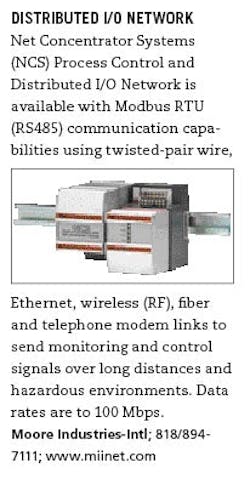Product Roundups: Ethernet Today, Wireless Tomorrow
Not terribly long ago, you could walk a trade show floor and hear no one talking about Ethernet. If they were talking about it, they most likely were lamenting about how Ethernet was nondeterministic and wouldn’t work on the factory floor. Times have changed.
Now, most major automation vendors’ products are Ethernet-enabled. Via the TCP/IP protocol, it is the principal network for both intranet and Internet connection between factories. By standardizing industrial networking applications, it is possible to standardize an entire enterprise from the plant floor to the corporate boardroom, on one network, providing access to data throughout the enterprise from anywhere around the world.
I asked a few I/O vendors to look into their crystal ball and tell me what they thought was the next thing in I/O. Skip Hansen, I/O systems product manager, Beckhoff Automation says “industrial Ethernet is an obvious trend because of lower cost cabling, switches and protocol implementation. Traditional fieldbus protocols required expensive, proprietary cards. ‘Standards’ have been established for newer protocols such as EtherCat, Modbus TCP, EtherNet/IP and Powerlink. Others are available, but tend to be complex to configure and expand.
Bruce Hofmann, product marketing manager, advanced connectivity, Weidmuller North America remarks that “the two common market trends we have seen in the market today are an increased need for and acceptance of the transportation of I/O using wireless technologies and industrial Ethernet products. Users often need to collect and/or manipulate I/O-based devices remotely which makes traditional wired systems expensive or physically challenging to deploy. The development of stable and reliable wireless devices now makes it possible to deploy or collect I/O signals across what used to be insurmountable geographic barriers such as waterways, roadways and railway systems or over large distances.”
Don Lupo, director of marketing and sales, process products at Acromag says, “Ethernet I/O products have proven to be easy to use, reliable and affordable. Future devices will deliver 10 times faster processing speeds. They will yield more functionality and actually take advantage of 100 Mbps+ bus bandwidths. Look for on-board advances using multiple media—Copper, Fiber 100Mbps and Wireless 802.11b/g/n/i—security/encryption, built-in support for redundant communications, and hardened performance specifications. For SCADA applications, Modbus TCP/IP protocol will continues to grow as the common thread for multi-vendor interoperability.”
- USB I/O Module
- Distributed I/O Network
- Fieldbus Segment Protectors
- Mini Terminal Block
- Cord Flex
- Thin I/O
- Select Your Termination
- Analog Output Module
- I/O Stations
- Bluetooth Wireless Transmission
- IEC Terminal Blocks
- Expansion I/O Modules
- Built In Conditioner
- Open Network I/O
- Interface Converters
- Analog Modules
- Terminal Blocks
- Rugged EtherNet/IP Modules
- Distributed I/O
- Ultra-Fast I/O
- Easy to Install
- IP67 Discrete I/O
- More I/O Options
- Snap That Module

